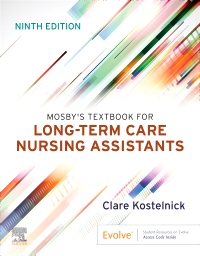
Mosby's Textbook for Long-Term Care Nursing Assistants - Elsevier eBook on VitalSource, 9th Edition
Elsevier eBook on VitalSource

Give your students the knowledge and skills they need to provide safe, compassionate long-term care! Mosby's Textbook for Long-Term Care Nursing Assistants, 9th Edition prepares students to succeed as professional caregivers for residents in long-term care settings. More than 100 step-by-step procedures include clear instructions for performing skills such as measuring vital signs, bedmaking, and collecting specimens. Not only does the book cover the functions and limitations of the nursing assistant’s role, but its delegation guidelines outline the information students need to collect from the nurse and care plan before performing and then documenting a procedure. With easy-to-follow coverage of all of the care required by OBRA, this text also helps students prepare for success on the Nursing Assistant certification exam.
-
- NEW! Updated photographs and illustrations show the latest equipment and supplies used in caring for long-term care residents
- NEW! Basic Emergency Care chapter has new, vital information on controlling bleeding and the Stop the Bleed program, as well as a description of equipment used in medical emergencies
- NEW! Preventing Infection chapter includes updates on PPE and changes to procedures related to COVID-19
- NEW! Mental Health Problems chapter adds information on dealing with individuals experiencing emotional pain and suicide prevention, as well as expanded information on types of depression
- NEW! Nutrition chapter adds new information on the important topic of residents experiencing dysphagia, including current guidelines from the International Dysphagia Diet Standardisation Initiative (IDDSI)
- Concise long-term care content is presented at a 6th-grade reading level to make understanding easier for readers of all levels and abilities (particularly ESL individuals)
- More than 100 procedures are divided into pre-procedure, procedure, and post-procedure sections for easier learning, and a NATCEP® icon in the procedure title bar indicates skills that are covered in certification exams
- Eight feature boxes emphasize principles of care for topics including Teamwork and Time Management, Quality of Life, Residents with Dementia, Time to Reflect, Promoting Safety and Comfort, Focus on Rehabilitation, Focus on Communication, and Delegation Guidelines
- Procedure icons in the headings identify content for which a related procedure is included
- Play icons in the Procedure boxes alert students to related video clips on the Evolve website
- Key Terms and Key Abbreviations at the beginning of each chapter introduce important words and commonly used abbreviations, and a separate glossary for each is included at the end of the book
- Chapter Review Questions help students evaluate learning
- Review Question Answers are included at end of the text to allow for self-evaluation
- Color illustrations and photographs depict key ideas, concepts, and procedure steps
-
- NEW! Updated photographs and illustrations show the latest equipment and supplies used in caring for long-term care residents
- NEW! Basic Emergency Care chapter has new, vital information on controlling bleeding and the Stop the Bleed program, as well as a description of equipment used in medical emergencies
- NEW! Preventing Infection chapter includes updates on PPE and changes to procedures related to COVID-19
- NEW! Mental Health Problems chapter adds information on dealing with individuals experiencing emotional pain and suicide prevention, as well as expanded information on types of depression
- NEW! Nutrition chapter adds new information on residents experiencing dysphagia, including current guidelines from the International Dysphagia Diet Standardisation Initiative (IDDSI)
-
1. The Nursing Assistant Working in Long-Term Care
2. Resident Rights, Ethics, and Laws
3. Work Ethics
4. Communicating with the Health Team
5. Assisting with the Nursing Process
6. Understanding the Resident
7. Culture and Religion
8. Body Structure and Function
9. The Older Person
10. Sexuality
11. Safety
12. Preventing Falls
13. Restraint Alternatives and Safe Restraint Use
14. Preventing Infection
15. Body Mechanics and Safe Resident Handling, Moving, and Transfers
16. The Resident’s Unit
17. Bedmaking
18. Hygiene
19. Grooming
20. Nutrition and Fluids
21. Nutritional Support and IV Therapy
22. Urinary Elimination
23. Bowel Elimination
24. Exercise and Activity
25. Comfort, Rest, and Sleep
26. Oxygen Needs and Respiratory Therapies
27. Measuring Vital Signs
28. Assisting With the Physical Examination
29. Collecting and Testing Specimens
30. Admissions, Transfers, and Discharges
31. Wound Care
32. Pressure Injuries
33. Hearing, Speech, and Vision Problems
34. Cancer, Immune System, and Skin Disorders
35. Nervous System and Musculoskeletal Disorders
36. Cardiovascular and Respiratory System Disorders
37. Digestive and Endocrine System Disorders
38. Urinary and Reproductive System Disorders
39. Mental Health Problems
40. Confusion and Dementia
41. Developmental Disabilities
42. Rehabilitation and Restorative Nursing Care
43. Assisted Living
44. Basic Emergency Care
45. End-of-Life Care
46. Getting a Job — Career Management
Review Question Answers
Appendixes
Glossary
Key Abbreviations
Index




 as described in our
as described in our 